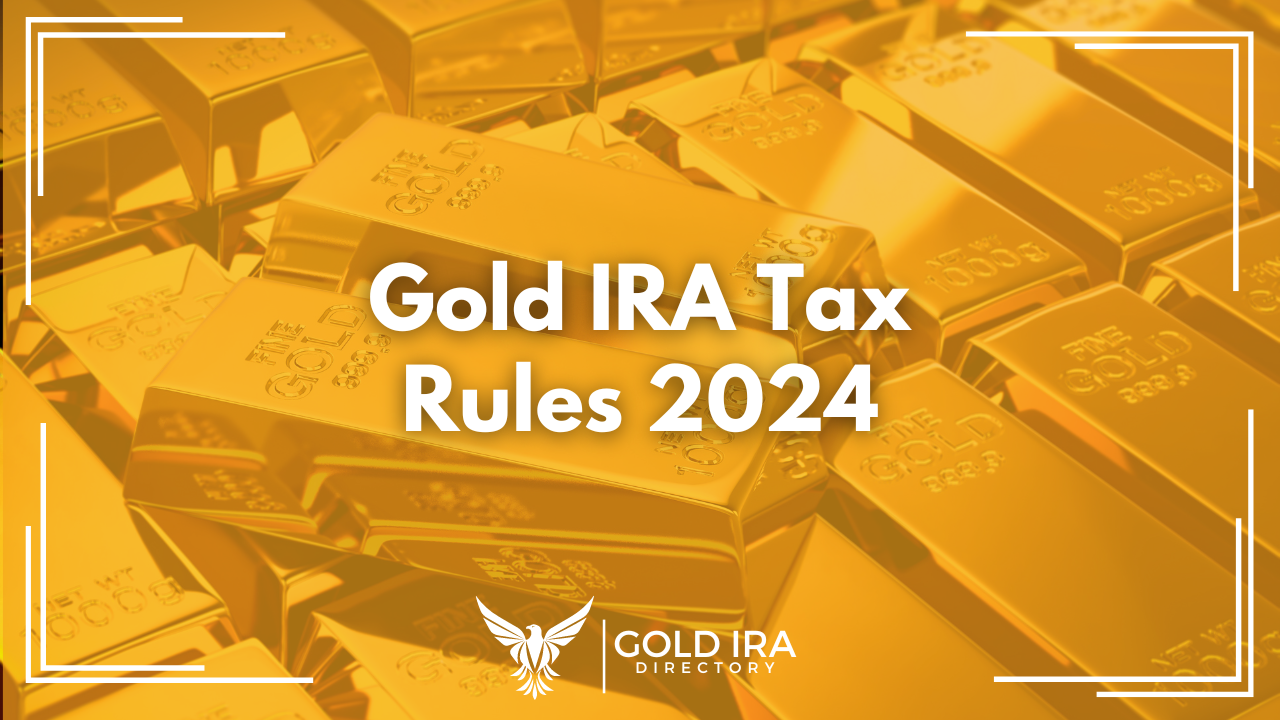
This article provides a thorough examination of the rules and guidelines related to Gold IRA withdrawals, taxes, and the regulations governing precious metals.

Putting Money In
- Think of a Gold IRA like a piggy bank for your retirement, but instead of coins, you’re saving gold.
- For 2024, you can put up to $7,000 in your Gold IRA piggy bank. If you’re 50 or older, you get an extra $1,000 allowance.
- With a traditional Gold IRA, you’re using “before-tax” money. It’s like getting a discount on your taxes now, but you’ll pay taxes later when you take the money out.
- For a Roth Gold IRA, you’re using money you’ve already paid taxes on. No tax break now, but you won’t pay taxes when you take it out later.
Tax Benefits
- Traditional Gold IRA: Think of it as a “tax delay” account. You don’t pay taxes on the money going in or while it’s growing, but you will when you take it out in retirement.
- Roth Gold IRA: This is more like a “tax-free growth” account. You’ve already paid taxes on the money, so when you take it out in retirement, it’s all yours – no taxes due.
Taking Money Out
- The government wants you to save this money for retirement, so they have some rules:
- You can start taking money out without penalty when you’re 59 1/2 years old.
- If you take money out earlier, you’ll have to pay a 10% penalty plus regular taxes.
- For traditional Gold IRAs, you must start taking some money out each year when you turn 72. We call these “required minimum distributions” or RMDs.
Storing Your Gold
- You can’t keep the gold at home under your mattress! It needs to be in a special, approved storage facility.
- If you decide to bring the gold home, the IRS will consider that as taking money out of your IRA, and you’ll have to pay taxes (and maybe penalties).
Other Important Points
- Gold IRAs can be a bit more expensive to maintain than regular IRAs because of storage costs.
- Not all gold is created equal in the eyes of the IRS. Only certain types of gold coins and bars are allowed in your IRA.
- If you’re self-employed, you might be able to save even more with a SEP Gold IRA.
Remember, while Gold IRAs can be a good way to diversify your retirement savings, they come with their own set of rules and costs. It’s always a good idea to chat with a financial advisor to see if it’s the right choice for your specific situation.
Essential Withdrawal Guidelines for Investors
For those looking into a Gold IRA withdrawal, it’s essential to grasp the important rules to steer clear of any unwanted taxes and penalties. Taking money out of a traditional Gold IRA before you hit 59 ½ comes with a 10% penalty, plus you’ll also have to pay taxes on it as regular income. However, Roth IRAs provide tax-free withdrawals, as long as the account has been open for a minimum of five years and the owner is at least 59 ½ years old.
Required minimum distributions (RMDs) become mandatory at age 72 for traditional IRAs, while Roth IRAs do not impose RMDs, enabling the investment to grow tax-free for the duration of the owner’s life. Investors need to thoughtfully decide whether to liquidate precious metals or opt for an in-kind distribution, as this choice will influence both market value and tax implications.
It’s wise to seek guidance from a financial adviser to help you understand the intricacies of IRS regulations. This will ensure that all transactions, whether you’re selling metals back to the bank or through a private sale, align with tax laws and reporting obligations. Thoughtful planning can enhance the worth of your retirement assets while reducing taxes and penalties.
Understanding Required Minimum Distributions
Understanding Required Minimum Distributions (RMDs) is essential for effectively managing a Gold IRA. At the age of 72, it’s required by the IRS to start withdrawing required minimum distributions (RMDs) from your retirement accounts, which includes traditional IRAs. However, Roth IRAs are exempt from this rule since they are funded with after-tax dollars and do not require RMDs until the account holder passes away.
When it comes to Gold IRAs, figuring out your required minimum distribution means looking at the account’s value from the end of last year and dividing that by the life expectancy factor given by the IRS. Consulting with a financial adviser is crucial for accurate calculations and discussing strategies to minimize tax liabilities.
Not taking the proper RMD can lead to a significant tax penalty—half of the amount that should have been taken out. Considering the potential complexities, particularly when it comes to physical assets such as precious metals, it’s wise to think about liquidating or transferring these metals to satisfy RMD requirements well ahead of the deadline.
Overseeing Inherited Accounts
When handling inherited Gold IRA accounts, it’s important to grasp the regulations established by the Internal Revenue Service (IRS). Inherited IRAs, even those that contain precious metals, must adhere to required minimum distributions (RMDs). The exact amount and timing are influenced by the beneficiary’s connection to the deceased and their age.
In the case of an inherited Roth IRA, distributions are typically tax-free; however, the account needs to be completely emptied within a ten-year period if the original owner died after 2019. This guideline highlights the necessity of strategizing for the sale of precious metal assets in a way that corresponds with market conditions to enhance value.
Beneficiaries ought to take into account how their tax situation might be affected, particularly if they decide to liquidate significant amounts of precious metals all at once. Seeking advice from a tax expert can assist in managing these intricacies, guaranteeing adherence to regulations while enhancing tax results.
In this situation, overseeing an inherited Gold IRA requires not just compliance with IRS rules but also thoughtful asset management to preserve the investment’s value and reach financial objectives, which may include covering costs such as higher education.
Adhering to Standards for Precious Metals
When you’re looking into a Gold IRA, it’s important to make sure that the precious metals you buy meet the standards established by the IRS. Metals are required to adhere to particular fineness standards: gold needs to be 99.5% pure, silver 99.9%, and both platinum and palladium must be 99.95% pure. Ensuring compliance is crucial not just for the legitimacy of your IRA, but it also impacts the tax-exempt status of your investment.

When it comes to buying precious metals for your IRA, it’s essential to work with a reputable dealer and coordinate with your custodian. This way, you can be sure that all transactions are compliant and well-documented. This documentation, typically presented as a receipt or wire confirmation, is essential for annual reporting to the IRS and for confirming the amount and quality of your investment.
The IRS requires that people of a specific age start taking required minimum distributions (RMDs) from their retirement accounts, which also includes Gold IRAs. The exact figure is influenced by the account balance and the investor’s anticipated lifespan. It’s worth mentioning that Roth IRAs don’t necessitate required minimum distributions during the owner’s lifetime, whereas traditional IRAs, even those containing precious metals, do have that requirement.
Failing to adhere to IRS regulations regarding precious metals in your IRA can result in taxes and penalties. Consequently, it’s important for investors to collaborate closely with their IRA custodian and a well-informed dealer to guarantee that every facet of their precious metal investments adheres to compliance standards.
The Function of Custodians and Authorized Depositories
Custodians hold an important position in managing a Gold IRA, acting as protectors of your valuable metals and making sure everything aligns with Internal Revenue Service (IRS) regulations. These organizations take on the important role of safeguarding your assets, enabling transactions, and supplying you with statements and details about your investments. Approved depositories are specialized storage facilities designed to securely hold your physical gold and other precious metals. They ensure the safety, coverage, and accurate tracking of your belongings.
Choosing the right custodian and depository is crucial, as it affects the security, cost, and ease of access to your gold investment. These organizations also help with the buying and selling of precious metals, carrying out transactions that adhere to IRS regulations to preserve the tax-advantaged status of your IRA. It’s crucial to make sure that any withdrawals comply with the necessary minimum distribution rules, to steer clear of unwanted taxes and penalties.
By collaborating with trusted custodians and recognized depositories, investors can simplify the management of their Gold IRA, concentrating on asset growth and tax-efficient strategies.
Implications of Not Following the Rules
Failing to adhere to the rules regarding Gold IRA withdrawals and taxes can result in significant financial penalties. If you have a traditional IRA, it’s important to know that not taking the Required Minimum Distribution (RMD) after you turn 72 can lead to a hefty 50% excise tax on the amount you were supposed to withdraw but didn’t.
Roth IRAs provide the benefit of tax-exempt growth, but they come with penalties for taking out earnings too early—specifically, before reaching age 59½ or before the account has been active for 5 years. This results in a 10% penalty on top of the usual income taxes.
Misreporting withdrawals or failing to follow precious metal regulations can lead to audits, additional taxes, or penalties. Therefore, it’s important to grasp the particular needs for precious metal IRAs, such as storage, valuation, and acceptable metals, to steer clear of unexpected tax implications and maintain the worth of your investment.
It’s important for investors to confirm transactions by keeping proper documentation and receipts. This helps ensure compliance and can prevent any disputes with tax authorities or custodians down the line.

Frequently Asked Questions
What are the tax implications of holding gold in an IRA?
Gold held in an IRA is subject to taxation when the investor decides to cash out, with any gains being taxed as ordinary income according to the investor’s marginal tax rate.
What’s the process for withdrawing my required minimum distribution from my gold IRA?
To obtain your required minimum distribution from your gold IRA, you have the option to either receive the physical precious metals directly or sell the metals and take your distributions in cash.
Is it possible to take money out of a gold IRA?
Indeed, you can take money out of a gold IRA, but if you’re younger than 59 ½, it will be seen as a non-qualified distribution and could lead to penalties.
What steps should I take to liquidate my gold IRA?
If you wish to liquidate your gold IRA, simply reach out to your gold IRA provider for assistance. Please request the buyback value for the portfolio and ensure that all relevant information and documentation is provided. Examine the purchase valuation to confirm its fairness, and they will handle the necessary paperwork for your signature.
What are the contribution limits for a gold IRA?
For 2024, the contribution limits are:
– $7,000 per year for individuals under age 50
– $8,000 per year for individuals age 50 and older
These are the same limits that apply to traditional and Roth IRAs.
How are withdrawals from a gold IRA taxed?
The tax treatment depends on the type of gold IRA:
– Traditional gold IRA: Withdrawals are taxed as ordinary income at your current tax rate. Early withdrawals before age 59 1/2 may incur an additional 10% penalty.
– Roth gold IRA: Qualified withdrawals in retirement are tax-free. Early withdrawals of earnings may be subject to taxes and penalties.
Are contributions to a gold IRA tax-deductible?
– Traditional gold IRA: Contributions may be tax-deductible in the year they are made, reducing your taxable income.
– Roth gold IRA: Contributions are made with after-tax dollars and are not tax-deductible.
How is gold in an IRA taxed when sold?
The IRS classifies physical gold and silver as collectibles, subject to a maximum tax rate of 28% on long-term capital gains when sold. However, if held in an IRA, taxes are deferred until withdrawal for a traditional IRA or potentially tax-free for a Roth IRA.
Are there special storage requirements for gold in an IRA?
Yes, physical gold in an IRA must be stored at an IRS-approved facility or depository. Storing gold at home is not allowed and would be considered a distribution, subject to taxes and potential penalties.
Can I take physical possession of gold from my IRA?
Taking physical possession of gold from your IRA is considered a distribution. For a traditional IRA, this would trigger income taxes and potentially early withdrawal penalties if you’re under 59 1/2.
What types of gold can be held in an IRA?
Only certain forms of gold meeting specific purity requirements can be held in an IRA. This typically includes certain gold coins and bars produced by accredited refiners or national government mints.
References:


